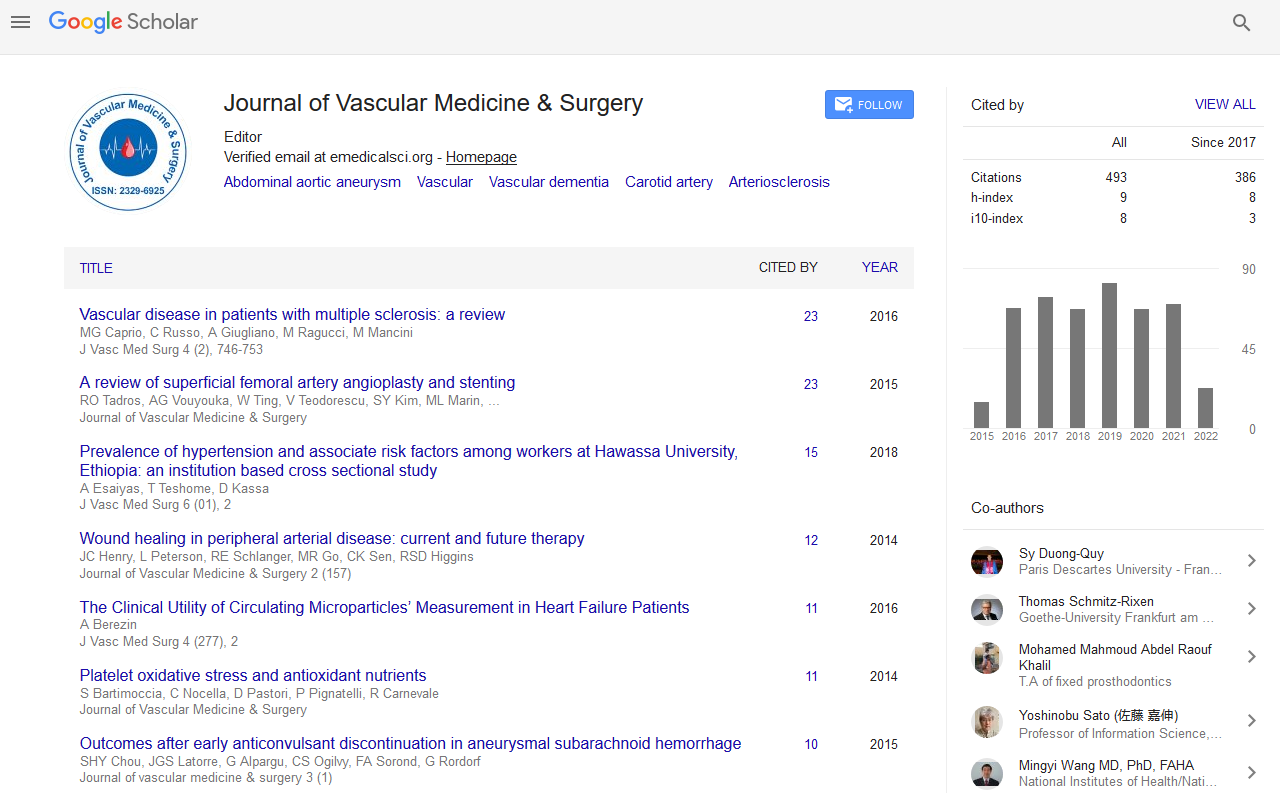Indexed In
- Open J Gate
- Academic Keys
- RefSeek
- Hamdard University
- EBSCO A-Z
- OCLC- WorldCat
- Publons
- Euro Pub
- Google Scholar
Useful Links
Share This Page
Journal Flyer

Open Access Journals
- Agri and Aquaculture
- Biochemistry
- Bioinformatics & Systems Biology
- Business & Management
- Chemistry
- Clinical Sciences
- Engineering
- Food & Nutrition
- General Science
- Genetics & Molecular Biology
- Immunology & Microbiology
- Medical Sciences
- Neuroscience & Psychology
- Nursing & Health Care
- Pharmaceutical Sciences
Abstract
Diagnosis and Treatment of Silent Coronary Ischemia May Reduce Adverse Cardiac Events and Improve Long-Term Survival of Patients Undergoing Lower-Extremity Revascularization
Dainis Krievins*, Edgars Zellans, Gustavs Latkovskis and Christopher Zarins
Background: Patients with Peripheral Artery Disease (PAD) undergoing lower-extremity revascularization are at increased risk of death and Myocardial Infarction (MI) due to co-existing Coronary Artery Disease (CAD) which is often unrecognized due to absence of chest pain symptoms. A new cardiac diagnostic test, coronary CT-derived Fractional Flow Reserve (FFRCT), can identify patients with unsuspected (silent) coronary ischemia. We sought to determine whether pre-operative diagnosis of silent coronary ischemia using FFRCT can facilitate multidisciplinary care to reduce post-operative death and MI and improve survival of PAD patients.
Methods: Symptomatic PAD patients with no cardiac history or symptoms were enrolled in a prospective, open-label study of coronary CTA and FFRCT testing before lower-extremity revascularization and were compared to historic control patients with standard pre-operative cardiac evaluation and care. Lesion-specific coronary ischemia was defined as FFRCT ≤ 0.80 distal to a coronary stenosis. Endpoints included Cardiovascular (CV) death, MI and allcause death through 1 year follow up.
Results: Baseline characteristics of the CTA-FFRCT (n=135) and Control (n=135) groups were similar with regard to age (66 ± 8 years), gender, co-morbidities and indication for surgery (>80% for CLTI). CTA-FFRCT evaluation revealed unsuspected (silent) coronary ischemia in 68% of patients and 40% of patients had elective post-operative coronary revascularization (PCI in 47, CABG in 7). The status of coronary ischemia was unknown in Control patients and none had elective coronary revascularization. At one year, CTA-FFRCT had fewer CV deaths (0.7% vs. 5.9%, p=0.04) and MIs (2.2% vs. 8.1%, p=0.03) and improved survival (99.3% vs. 94.1%, p=0.02) compared to Control.
Conclusion: Pre-operative diagnosis of silent coronary ischemia in patients undergoing lower-extremity revascularization surgery can identify high-risk patients and facilitate multi-disciplinary patient care with selective post-operative coronary revascularization. This strategy reduced post-operative death and MI and improved one-year survival compared to standard care.
Published Date: 2021-09-07; Received Date: 2021-08-06


